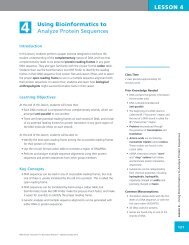WET LAB DNA Barcoding: From Samples to Sequences - Northwest ...
WET LAB DNA Barcoding: From Samples to Sequences - Northwest ...
WET LAB DNA Barcoding: From Samples to Sequences - Northwest ...
You also want an ePaper? Increase the reach of your titles
YUMPU automatically turns print PDFs into web optimized ePapers that Google loves.
<strong>WET</strong> <strong>LAB</strong><br />
Sometimes the amount of <strong>DNA</strong> in each band of the molecular weight standard<br />
is also known, so that scientists can estimate the amount of <strong>DNA</strong> in their<br />
samples. This is covered in more detail in Slide #19.<br />
c. The <strong>DNA</strong> samples are in Lanes 2–10.<br />
d. <strong>DNA</strong> gels are stained, in this case with a chemical called ethidium bromide,<br />
<strong>to</strong> visualize the <strong>DNA</strong>.<br />
e. Examples of the sizes of four molecular weight standard bands are shown:<br />
5000 base pairs (bp), 2000 bp, 1000 bp, and 750 bp.<br />
23. Ask students <strong>to</strong> estimate the sizes of the bands in Lane 2 (yellow<br />
arrow). The bot<strong>to</strong>m band is approximately 900 bp, while the band above<br />
it is approximately 4500 bp. [Note: Lanes 2, 3, and 4 contain bands of<br />
approximately 900 and 4500 bp.]<br />
24. Show Slide #14, which reviews the steps involved in agarose gel<br />
electrophoresis: making the gel, preparing your samples, loading your samples<br />
on<strong>to</strong> the gel, running the gel, and visualizing the gel. If your students have<br />
experience making and running agarose gels, you may wish <strong>to</strong> skip <strong>to</strong> Step<br />
#33. If your students do not have experience making and running agarose<br />
gels, you may wish <strong>to</strong> show one or more of the tu<strong>to</strong>rial videos listed above<br />
under Lab 3: Teacher Preparation.<br />
Wet Lab: Slide #14<br />
Using Bioinformatics: Genetic Research<br />
Wells: Holes in a gel in<strong>to</strong> which samples<br />
are placed or “loaded.”<br />
25. Show Slide #15, which reviews the first step: making the agarose gel. Tell<br />
students that agarose is made from a chemical called agar that is isolated<br />
from seaweed. Agar is also used as a thickening agent, and is what gives<br />
many consumer products their characteristic texture, including many sauces,<br />
puddings, and custards. The final product is similar in consistency <strong>to</strong> Jell-O ®<br />
and, as with Jell-O ® , the agarose is melted and poured in<strong>to</strong> a mold. A small<br />
comb is placed in the liquid <strong>to</strong> form the holes or wells in<strong>to</strong> which the <strong>DNA</strong><br />
will be loaded.<br />
336<br />
©<strong>Northwest</strong> Association for Biomedical Research—Updated Oc<strong>to</strong>ber 2012
















